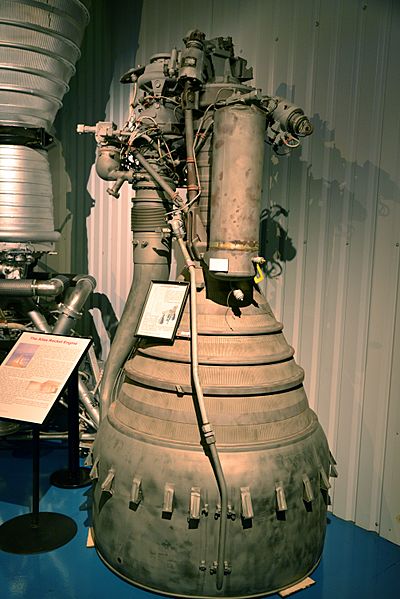Image: Stafford Air & Space Museum, Weatherford, OK, US (34)

Description: A Rocketdyne LR-105 rocket engine, the central sustainer engine of the Atlas rocket. The Atlas, developed in the late 1950s as the U.S.'s first intercontinental ballistic missile, also had a long career as a space launch vehicle, being best known for launching all of Project Mercury's orbital missions. The Atlas had three main engines, a central sustainer engine and two flanking booster engines. Each of the booster engines provided more thrust than the sustainer, but the boosters shut down first, being jettisoned around two minutes after liftoff. (Because the Atlas jettisoned its booster engines, it is called a "stage-and-a-half" rocket.) After the jettisoning of the boosters, the sustainer engine continued to burn for another three minutes or so. The LR-105 had about 57,000 lbf (26,000 kgf; 250 kN) of thrust at sea level, which was about the same as the thrust of the German V-2, but the Atlas sustainer engine's total burn time of around five minutes was five times as long as the V-2 engine. The Atlas engines were all liquid-fueled, using liquid oxygen as their oxidizer and burning a refined form of kerosene known as RP-1. The sustainer and booster engines were fed from the same tanks, using turbopumps. The gas generator for these turbopumps ran directly off the engine propellants, rather than using a separate set of chemicals as in the V-2. The Atlas engines were steered with gimbals to guide the rocket in flight. The engine here is in a somewhat stripped-down condition. At the top are the turbopumps, their gas generator, and other associated plumbing, as well as the gimbal swiveling mechanism. The large pipe running down the left rear side of the thrust chamber is the turbopump turbine's exhaust duct, which leads into the outer rim of the thrust chamber. This helps keep the engine from being overheated by premature ignition of the turbine exhaust, which still has some unburned fuel due to incomplete combustion in the gas generator. Displayed at the Stafford Air & Space Museum, Weatherford, Oklahoma, U.S.
Title: Stafford Air & Space Museum, Weatherford, OK, US (34)
Credit: Own work
Author: Bubba73
Usage Terms: Creative Commons Attribution-Share Alike 3.0
License: CC BY-SA 3.0
License Link: https://creativecommons.org/licenses/by-sa/3.0
Attribution Required?: Yes
Image usage
The following page links to this image:

